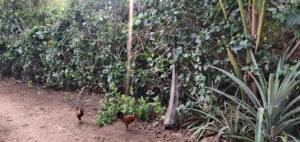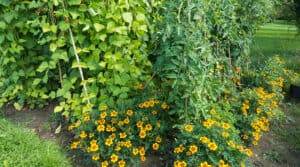Fresh water is one of the most important natural resources on our planet. An integrated permaculture approach needs to consider the world’s water cycle, and think about how fresh water is used and conserved.
Fresh water is already a scarce resource in many parts of the world, and is becoming an increasing concern on more parts of our planet. It is likely that fresh water availability is one of the key issues that humanity will face moving forward.
Permaculture approaches to all facets of life must take into account the pathways of fresh water. Those designing sustainable systems must think about:
- how fresh water can be conserved and utilised effectively.
- how land can be managed to maintain the integrity of the water cycle and channel water to where it is needed
- and how grey or waste water can best be reclaimed.
In order to design effective permaculture systems, the precious resource of fresh water must always be at the forefront of our minds.
Understanding The World’s Water Cycle
Understanding the world’s water cycle is crucial to understanding how water should be managed on a macro and micro scale in permaculture systems.
How quickly water cycles depends on where it is stored. It is important to understand how the cycle perpetuates, both on a long-term and short-term basis, if we are to effectively manage the cycle to sustain our way of life on Earth.
As children, we all learn that water from the oceans evaporates in sunlight, condenses as clouds and falls as rain, then the cycle repeats itself. What few people truly understand is the important role that trees have to play in the water cycle.
Trees & Vegetation’s Impact on the World’s Water Cycle
Deforestation can significantly reduce rainfall in a given area. It affects the formation of Eckman spirals, air currents that increase precipitation. It reduces the amount of cloud cover formed due to transpiration and evaporation. It also reduces the organic particles sent airborne which form nucleii for condensation and allow rain to form. If we clear our forests, we significantly disrupt our water cycles.
Planting trees and replacing forest cover also impacts rainfall patterns and can have complex results when it comes to the water cycle, and weather patterns across a region. Understanding more about the impacts of planting trees, and other decisions made about broad-scale ecosystem restoration is crucial for permaculture design at landscape scale.
By recognising the importance of trees and other vegetation to the world’s water cycles, by conserving natural forested areas and reforesting degraded land, permaculture designers can engineer environments better able to preserve and conserve the water that we need for life on this planet.
Of course, on most permaculture projects, and when implementing permaculture ideas in our gardens, we will not necessarily have to grapple with these larger planetary issues. But at least some understanding of the world’s water systems is crucial in order to make the right decisions on a smaller scale.
The Impact of Soil on the Water Cycle
Soil, too, is crucially important to the water cycle. And how we manage, maintain and protect the soil on our properties has a direct bearing how it functions within the global water cycle.
Mismanagement of agricultural land means that much of the world’s topsoil is threatened. Barren areas used for crops, especially in dry-land areas, are often degraded to the degree that they require urgent remediation work to be able to absorb, store and cycle water as they should.
Degraded land, left bare, is prone to water run-off, which can destroy topsoil ecosystems and in extreme cases, lead to a complete loss of the valuable growing medium. By effectively managing water flow, permaculture systems can prevent and reverse land degradation and protect the world’s soils.
Permaculture practices such as careful and thoughtful planting, adding trace elements and organic matter through mulching and organic feeds, non-destructive agricultural practices of well-managed natural yields, sparse grazing and conservation farming are said to be able to increase the ability of the soils to hold and infiltrate water by up to 70-85%.
The Impact of Plants on the Water Cycle
In local microclimates, the water in vegetation can serve to moderate extreme temperatures, cooling the air when it is hot and preventing extreme chills in cold climates. Crops and other vegetation will both release water to the airstreams and absorb it.
In an arid climate, biological reserves of water in the nuts and fruits, leaves and specific organs of various plants provide crucial storage of water which can sustain human and animal life.
Clever selection of plant life in a permaculture system can help to conserve and store fresh water, as well as helping to perpetuate the water cycle.
Managing water on permaculture land, however, often involves more than just planting trees and other vegetation, and managing and caring for the soil.
Though we should always be sure to begin from a basic understanding of water systems on the broadest of scales, we can also look deeper into the issue of water management from a permaculture perspective to achieve specific results.
Looking at Sectors and Flow in Water Management
In permaculture, an understanding not only of the water cycle but also of how water moves through a landscape is key.
In the design stage, an understanding of the pathways taken by water across and through a site is used to select zones for food production and other things, and to manage water to allow natural systems to flourish for human benefit.
Looking at topography, as well as things like rainfall, designers can begin to determine how best to catch, store, slow, direct or otherwise manage that water to achieve their goals.
Water Management in Permaculture Systems
Combining knowledge of the site and local conditions with an understanding of the water cycle and patterns of water flow allows us to develop strategies for:
- Slowing, Catching and Storing Water on a Property.
- Directing Water To Where it is Required.
- Diverting Excessive Water to Prevent Flooding or Erosion Issues.
- Water Wise Irrigation Systems/ Growing Systems for Drier Zones.
- Sustainable Grey Water and Wastewater Management.
Of course, the specific strategies implemented will depend in large part on where a site is located, and the availability of water. But some examples illustrating the permaculture approach to water management are outlined below.
Permaculture Earthworks for Water Management
Permaculture design always begins with observation and analysis of a site, and aims to work with nature to achieve desired goals. When it comes to intervention, less is often more. But sometimes earthworks are desired for water management.
For example, a permaculture design for a site might include:
On-Contour Swales and Berms
On-contour swales are level channels created across a more gentle slope that help to prevent runoff and erosion, slowing and capturing runoff and facilitating its infiltration into the soil. Berms on the downhill side of these swales, and sometimes in arid areas the swales themselves, are planted up with appropriate planting.
Infiltration Basins, Sunken Gardens, & Waffle Gardens
In dry climates in particular, clay-lined basins, or sunken areas are sometimes incorporated into a design. These areas, lower than the surrounding soil level, are designed to catch water within the landscape.
One example of an infiltration basin is the organic-matter filled pit at the centre of a banana or papaya circle. Another is the concept of a waffle garden, where a series of sunken garden beds are formed which look like a waffle from above.
Bioswales
Another form of swale that might be used in a permaculture design is a bioswale, or vegetated swale. These swales or ditches slowly move water through a landscape, and are used to manage stormwater and runoff. These sorts of swales are typically planted up with species that help to filter water.
Check Dams
Check dams are also commonly added along drainage channels or bioswales that slow the course of the water through the system, increasing the amount of water infiltrated into the ground.
Terracing
On steeper slopes, terracing is often employed where swales would not be suitable. Terracing is also about slowing the flow of water downhill and increasing infiltration and is also used to provide level areas for growing or construction on a site.
Keyline Design
Keyline design is a more complex landscaping technique that can reduce the need for terracing and maximize the beneficial use of the water resources of a site. Through the identification of ridges and valleys in topography, keyline design can mean constructing interconnecting channels to spread out water flow and optimize infiltration of rainfall, or plowing according to specific landscape patterns.
Planting for Water Management and Water Conservation
Earthworks are only ever part of the equation, and in permaculture design, any earthworks that are implemented go hand in hand with planting with appropriate and site-specific species.
Planting on Slopes
One key area to explore is planting on slopes, and how specific deep-rooted and shallow-rooted groundcover species can be utilized to stabilize the soil and reduce water runoff and erosion.
Rain Gardens
Another interesting area to explore when it comes to planting for water management are rain garden plants. Rain gardens are specific types of infiltration basins, into which rainwater harvested from a home or paved areas is directed. These are carefully designed for a specific site, and planted up with specific native plants that can tolerate wet and dry conditions as rainfall fluctuates throughout the year.
Ponds, Wetlands, and Bog Gardens
Plants that like wet or waterlogged conditions, as well as aquatic and marginal pond species, can also be crucial in water management in a permaculture design. Whether looking at naturally wet areas of a landscape, or constructed areas, choosing the right plants for such environments is crucial to a design, since the plants are important for the long-term function of a pond or other water element.
Xeriscaping & Water-Wise Native Planting
Of course, in areas where natural rainfall is in short supply, choosing the right plants is key to establishing a low-water-use system and conserving what precious freshwater there is. Drought-tolerant landscaping (xeriscaping) is hugely important in dry climates, and in any climate, water-wise native planting can be beneficial in a range of ways to reduce the need for any form of irrigation.
Irrigation Systems & Water-Based Growing
In some climate zones, irrigation will be required in at least some areas of a site. But by choosing growing methods that minimize water use, and choosing the right irrigation or water-based growing methods, far less freshwater can be squandered in the pursuit of food production.
Watering Globes and Clay Pot Irrigation
In gardens and smaller planting schemes, small-scale methods of slow and water-wise irrigation might be used. These include, for example, the use of watering globes or clay pots that allow water to slowly seep out into the soil around plant roots as needed.
Drip Irrigation Systems
On a larger scale, drip irrigation systems are far more efficient and use less water than other methods of irrigation – delivering water to plant roots where it is required.
Wicking Beds
Wicking beds are another water-wise solution, which involves creating raised beds with a reservoir of water at the base. Water is drawn up through the growing medium above via capillary action, providing water for plants growing in the bed.
Chinampas/ Reconstructed Wetland Systems
Water-wise schemes can also involve more complex systems – such as those based on the ancient Aztec ‘islands’ or chinampas used as growing areas within shallow waters. Chinampas are islands of soil/silt and reeds build up amid shallow waters or in intermittently flooded areas, which were used for agricultural production.
Aquaponics
Chinampas were often also a rudimentary form of aquaponics – involving the cultivation of fish as well as plants. There are many aquaponics systems, on a range of scales, that can be employed in water-wise permaculture systems.
An aquaponics system is any system where we rear both fish and plants together, in ways that work synergistically for the benefit of the whole. Combining fish rearing with water-based food production means that you can create closed-loop systems, with multiple yields. And conserve fresh water too.
Sustainable Grey Water and Wastewater Management
Permaculture helps us find the points of intersection between natural environments, gardens, and living environments, or homes. Holistic designs can be about more than just food production. They can also deal with issues of sustainable water use and water management within our homes.
Reed Bed Grey Water Filtration
For example, grey water from sinks and washing machines can be used to flush toilets (where flush toilets are used), and can also be filtered for use in irrigation etc.. through plant-based filtration systems, or reed beds.
Composting Toilets & ‘Humanure’ Systems
In certain cases, it is possible to avoid the use of water altogether in managing human waste. Instead, there are composting toilet systems that can be used, and safe and sustainable hot composting methods that can safely allow for the use of ‘humanure’ for fertilization.
Sustainable Wastewater Treatment
Alternatively, sustainable, natural wastewater treatment options using bioremediation to clean wastewater and sewage can help make sure humans avoid negative impacts on their environment.
Of course, these examples given above are just some of the natural and sustainable solutions that permaculture can offer for a range of the problems and challenges we face when it comes to water on our properties.
As permaculture teaches us, we need to design specific to site, and water management is often one of the most important considerations in any design.







